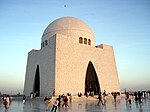Minnagara
| Part of a series on the |
| History of Karachi |
|---|
 |
| Prehistoric period |
| Ancient period |
| Classical period |
| Islamic period |
|
| Local dynasties |
| British period |
|
| Independent Pakistan |
|
Minnagara (
Barygaza
.

Minnagara is mentioned in the 1st century CE Periplus of the Erythraean Sea:
- "Beyond this region (Sinthus, the greatest of all the rivers that flow into the Erythraean Sea, bringing down an enormous volume of water (...) This river has seven mouths, very shallow and marshy, so that they are not navigable, except the one in the middle; at which by the shore, is the market-town, Barbaricum. Before it there lies a small island, and inland behind it is the metropolis of Scythia, Minnagara; it is subject to Parthian princes who are constantly driving each other out."[3]
A second Minnagara is mentioned in the Periplus, which seems to be upstream of
Barigaza
:
41. "Beyond the
Syrastrene. It is a fertile country, yielding wheat and rice and sesame oil and clarified butter, cotton and the Indian cloths made therefrom, of the coarser sorts. Very many cattle are pastured there, and the men are of great stature and black in color. The metropolis of this country is Minnagara, from which much cotton cloth is brought down to Barygaza."— Periplus of the Erythraean Sea, Chap. 41 [4]
Barigaza, and below Ujjain
:
Moreover the region which is next to the western part of India, is called Scythia. A part of this region around the (Indus) river mouth is
Tiastani(...) Minnagara".— Ptolemy Geographia, Book Seven, Chapter I
Minnagara may be identical with the Manjábarí of the Arab geographers.
Alternatively, "Nagara" being the Sanskrit word for "town", the city itself may have been called "Min", a name found in
Sakastan
(Lassen).
See also
- Maheshwar
- Krokola
- Kolachi (port)
- Debal
- Bhambore
- Barbarice
- Periplus of the Erythraean Sea
- Oraea
- Barbarikon
Notes
External links
